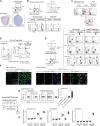The PTEN pathway in Tregs is a critical driver of the suppressive tumor microenvironment
- PMID: 26601142
- PMCID: PMC4640592
- DOI: 10.1126/sciadv.1500845
The PTEN pathway in Tregs is a critical driver of the suppressive tumor microenvironment
Abstract
The tumor microenvironment is profoundly immunosuppressive. We show that multiple tumor types create intratumoral immune suppression driven by a specialized form of regulatory T cell (Treg) activation dependent on the PTEN (phosphatase and tensin homolog) lipid phosphatase. PTEN acted to stabilize Tregs in tumors, preventing them from reprogramming into inflammatory effector cells. In mice with a Treg-specific deletion of PTEN, tumors grew slowly, were inflamed, and could not create an immunosuppressive tumor microenvironment. In normal mice, exposure to apoptotic tumor cells rapidly elicited PTEN-expressing Tregs, and PTEN-deficient mice were unable to maintain tolerance to apoptotic cells. In wild-type mice with large established tumors, pharmacologic inhibition of PTEN after chemotherapy or immunotherapy profoundly reconfigured the tumor microenvironment, changing it from a suppressive to an inflammatory milieu, and tumors underwent rapid regression. Thus, the immunosuppressive milieu in tumors must be actively maintained, and tumors become susceptible to immune attack if the PTEN pathway in Tregs is disrupted.
Keywords: PTEN; Regulatory T cells; Tregs; indoleamine 2,3-dioxygenase; tumor immunology; tumor microenvironment.
Figures






References
-
- Duan F., Duitama J., Al Seesi S., Ayres C. M., Corcelli S. A., Pawashe A. P., Blanchard T., McMahon D., Sidney J., Sette A., Baker B. M., Mandoiu I. I., Srivastava P. K., Genomic and bioinformatic profiling of mutational neoepitopes reveals new rules to predict anticancer immunogenicity. J. Exp. Med. 211, 2231–2248 (2014). - PMC - PubMed
-
- Coulie P. G., Van den Eynde B. J., van der Bruggen P., Boon T., Tumour antigens recognized by T lymphocytes: At the core of cancer immunotherapy. Nat. Rev. Cancer 14, 135–146 (2014). - PubMed
-
- Gubin M. M., Zhang X., Schuster H., Caron E., Ward J. P., Noguchi T., Ivanova Y., Hundal J., Arthur C. D., Krebber W.-J., Mulder G. E., Toebes M., Vesely M. D., Lam S. S. K., Korman A. J., Allison J. P., Freeman G. J., Sharpe A. H., Pearce E. L., Schumacher T. N., Aebersold R., Rammensee H.-G., Melief C. J. M., Mardis E. R., Gillanders W. E., Artyomov M. N., Schreiber R. D., Checkpoint blockade cancer immunotherapy targets tumour-specific mutant antigens. Nature 515, 577–581 (2014). - PMC - PubMed
-
- Snyder A., Makarov V., Merghoub T., Yuan J., Zaretsky J. M., Desrichard A., Walsh L. A., Postow M. A., Wong P., Ho T. S., Hollmann T. J., Bruggeman C., Kannan K., Li Y., Elipenahli C., Liu C., Harbison C. T., Wang L., Ribas A., Wolchok J. D., Chan T. A., Genetic basis for clinical response to CTLA-4 blockade in melanoma. N. Engl. J. Med. 371, 2189–2199 (2014). - PMC - PubMed
Grants and funding
- P01 AI056299/AI/NIAID NIH HHS/United States
- U01 AI083005/AI/NIAID NIH HHS/United States
- P01 CA065493/CA/NCI NIH HHS/United States
- R01 HL118979/HL/NHLBI NIH HHS/United States
- P30 CA008748/CA/NCI NIH HHS/United States
- R01 CA103320/CA/NCI NIH HHS/United States
- R01 CA096651/CA/NCI NIH HHS/United States
- R01 AI034495/AI/NIAID NIH HHS/United States
- R01 HL056067/HL/NHLBI NIH HHS/United States
- R01 CA072669/CA/NCI NIH HHS/United States
- P01 CA142106/CA/NCI NIH HHS/United States
- R01 AI077610/AI/NIAID NIH HHS/United States
- R01 CA112431/CA/NCI NIH HHS/United States
- R01 AI103347/AI/NIAID NIH HHS/United States
LinkOut - more resources
Full Text Sources
Other Literature Sources
Molecular Biology Databases
Research Materials

